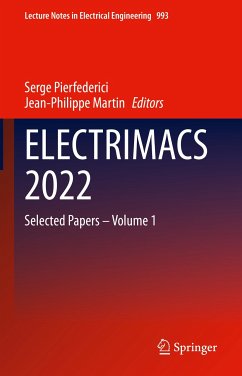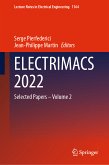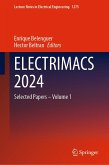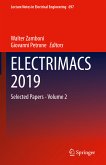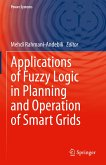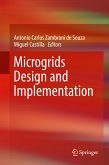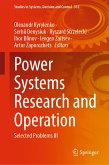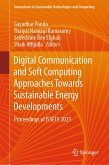ELECTRIMACS 2022 (eBook, PDF)
Selected Papers - Volume 1
Redaktion: Pierfederici, Serge; Martin, Jean-Philippe


Alle Infos zum eBook verschenken

ELECTRIMACS 2022 (eBook, PDF)
Selected Papers - Volume 1
Redaktion: Pierfederici, Serge; Martin, Jean-Philippe
- Format: PDF
- Merkliste
- Auf die Merkliste
- Bewerten Bewerten
- Teilen
- Produkt teilen
- Produkterinnerung
- Produkterinnerung

Hier können Sie sich einloggen

Bitte loggen Sie sich zunächst in Ihr Kundenkonto ein oder registrieren Sie sich bei bücher.de, um das eBook-Abo tolino select nutzen zu können.
This book collects a selection of papers presented at ELECTRIMACS 2021, the 14th international conference of the IMACS TC1 Committee, held in Nancy, France, on 16th-19th May 2022. The conference papers deal with modelling, simulation, analysis, control, power management, design optimization, identification and diagnostics in electrical power engineering. The main application fields include electric machines and electromagnetic devices, power electronics, transportation systems, smart grids, renewable energy systems, energy storage like batteries and supercapacitors, fuel cells, and wireless…mehr
- Geräte: PC
- ohne Kopierschutz
- eBook Hilfe
- Größe: 38.96MB
![ELECTRIMACS 2022 (eBook, PDF) ELECTRIMACS 2022 (eBook, PDF)]() ELECTRIMACS 2022 (eBook, PDF)169,95 €
ELECTRIMACS 2022 (eBook, PDF)169,95 €![ELECTRIMACS 2024 (eBook, PDF) ELECTRIMACS 2024 (eBook, PDF)]() ELECTRIMACS 2024 (eBook, PDF)193,95 €
ELECTRIMACS 2024 (eBook, PDF)193,95 €- -24%11
![ELECTRIMACS 2019 (eBook, PDF) ELECTRIMACS 2019 (eBook, PDF)]() ELECTRIMACS 2019 (eBook, PDF)161,95 €
ELECTRIMACS 2019 (eBook, PDF)161,95 € ![Applications of Fuzzy Logic in Planning and Operation of Smart Grids (eBook, PDF) Applications of Fuzzy Logic in Planning and Operation of Smart Grids (eBook, PDF)]() Applications of Fuzzy Logic in Planning and Operation of Smart Grids (eBook, PDF)97,95 €
Applications of Fuzzy Logic in Planning and Operation of Smart Grids (eBook, PDF)97,95 €![Microgrids Design and Implementation (eBook, PDF) Microgrids Design and Implementation (eBook, PDF)]() Microgrids Design and Implementation (eBook, PDF)137,95 €
Microgrids Design and Implementation (eBook, PDF)137,95 €![Power Systems Research and Operation (eBook, PDF) Power Systems Research and Operation (eBook, PDF)]() Power Systems Research and Operation (eBook, PDF)161,95 €
Power Systems Research and Operation (eBook, PDF)161,95 €![Digital Communication and Soft Computing Approaches Towards Sustainable Energy Developments (eBook, PDF) Digital Communication and Soft Computing Approaches Towards Sustainable Energy Developments (eBook, PDF)]() Digital Communication and Soft Computing Approaches Towards Sustainable Energy Developments (eBook, PDF)178,95 €
Digital Communication and Soft Computing Approaches Towards Sustainable Energy Developments (eBook, PDF)178,95 €-
-
-
Dieser Download kann aus rechtlichen Gründen nur mit Rechnungsadresse in A, B, BG, CY, CZ, D, DK, EW, E, FIN, F, GR, HR, H, IRL, I, LT, L, LR, M, NL, PL, P, R, S, SLO, SK ausgeliefert werden.
- Produktdetails
- Verlag: Springer International Publishing
- Seitenzahl: 632
- Erscheinungstermin: 13. Juni 2023
- Englisch
- ISBN-13: 9783031248375
- Artikelnr.: 68257559
- Verlag: Springer International Publishing
- Seitenzahl: 632
- Erscheinungstermin: 13. Juni 2023
- Englisch
- ISBN-13: 9783031248375
- Artikelnr.: 68257559
- Herstellerkennzeichnung Die Herstellerinformationen sind derzeit nicht verfügbar.
